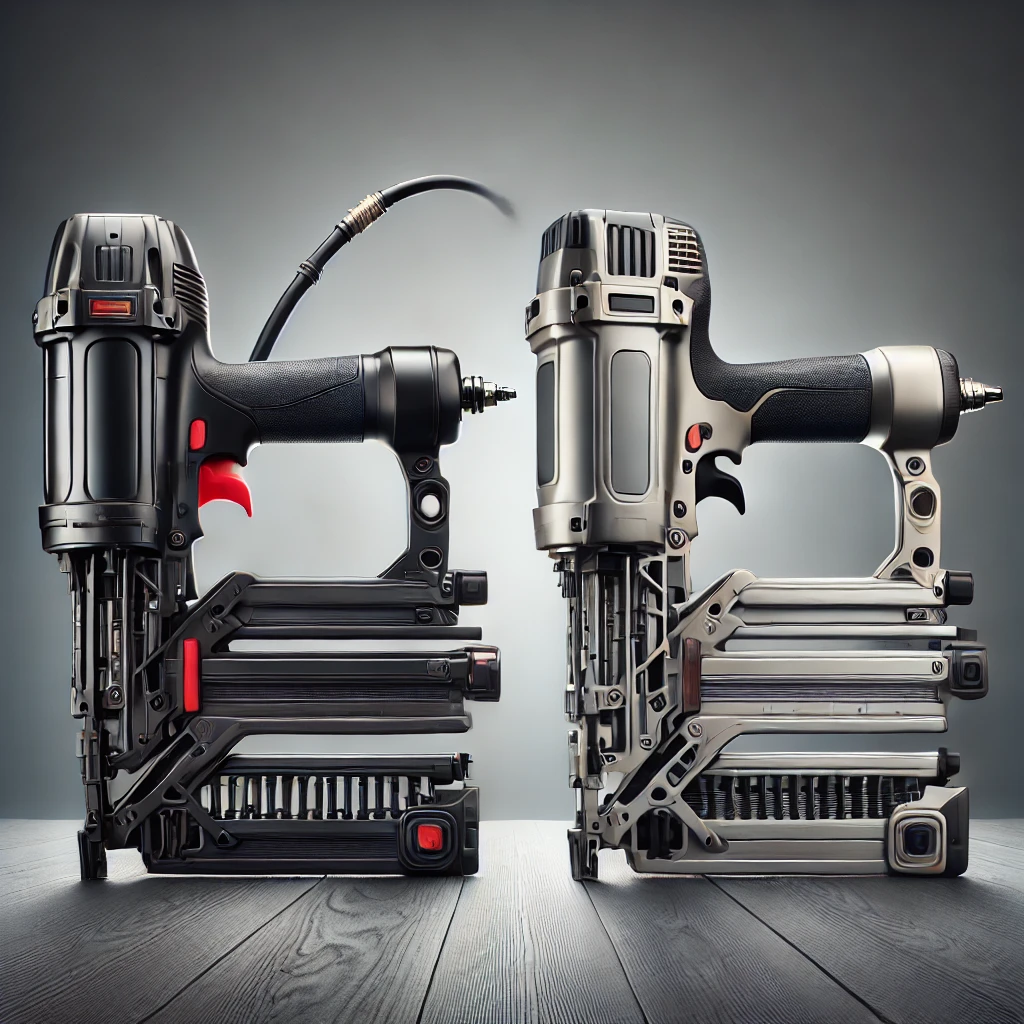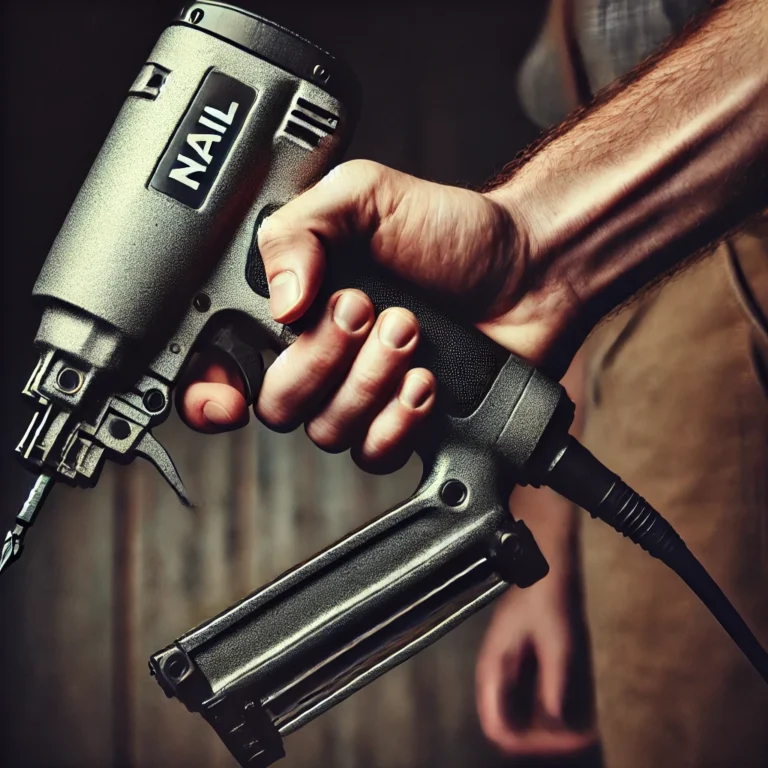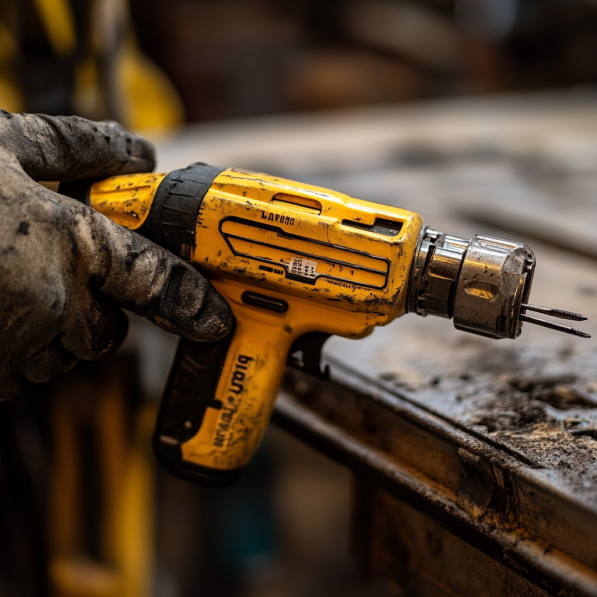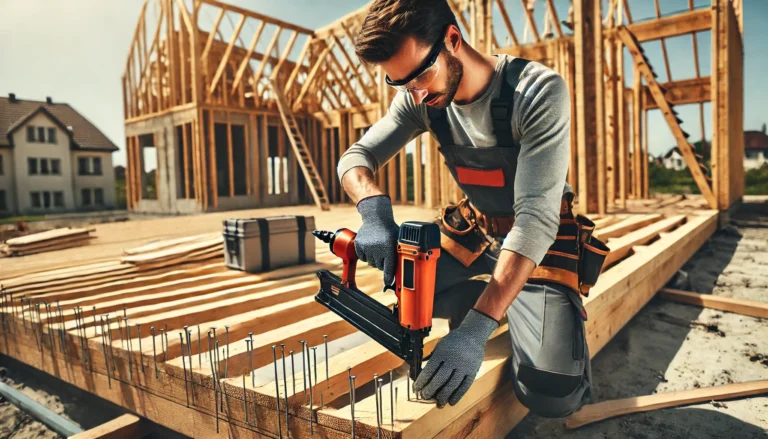Best Framing Nailer: Pneumatic & Cordless Framing Nailer Reviews
Is it time to finally build that big backyard deck? Maybe there are some rotten places on your roof, or even worse, the floor you’re standing on!
Just imagine: while you wrestle with bags of nails and screws in one hand, the hammer slips out of the other. Then who is holding the boards in place?

Unfortunately, there is no magic potion that will help you grow 5 extra arms. Instead, find the best framing nailer for your tool box! It’ll save you tons of time, stress, and sweat. Make room on your wish list and check out our framing nailer reviews!
BEST PNEUMATIC FRAMING NAILER REVIEWS
1. BOSTITCH F21PL
Rough lumber doesn’t stand a chance against this powerful framing nailer. Not only does the proof lie in its performance, but in the numbers too. This monster nailer has a power-to-weight ratio of 1,050in./lbs. to 8.1-lbs.
With this kind of muscle, it is going to be slightly heavy at 8-lbs. However, that’s exactly what makes it perfect for heavy duty jobs on-site or in your backyard. Since it’s such a heavy duty tool, it’s wise to use a larger air compressor although a standard one can work.
Beyond its power, the next greatest feature is its versatility. Use its quick-change nosepieces to switch between framing and metal connector nails. While you would think this should be standard for a framing nailer, it’s actually not!
Even though you’re spending a chunk of cash here, it’s because you’re getting a fantastic two-in-one deal. Spend a few extra dollars and save yourself the price tag of a metal connector nailer!
On top of that, you’ll save a lot of hassle with its 16-in layout indicator. You’ll be throwing up studs and rafters quicker than ever before.
Best Feature:
- Highest power-to-weight ratio.
- 16-in layout indicator.
- Head adjusts to switch between nail sizes.
- Fits between frames.
- Strongest nailer on our list.
- Uses multiple types of nails.
Specifications:
- Capacity: 60 Nail Magazine.
- Uses: 1-1/2” to 3-1/2” plastic collated, round head nails between 21 – 23 degrees.
2. NUMAX SFR2190
While we don’t suggest this economic nailer for large projects or everyday use, it is a DIY’ers dream.
Although it’s proven to be durable through drops and slips, it doesn’t handle heavy duty work well for one reason. Rather than being machine-forged, it’s instead formed or stamped. That means it’s perfect around the house, but not on a contract job.
Otherwise, it offers every convenient feature that allows you to work quickly without hassle. Our favorite is the interchangeable triggers that switch between single and bump firing. If you’re a beginner or otherwise lacking experience, the single-sequential trigger is ideal for your safety.
However, those boards aren’t safe from the heat-treated steel driver blade that consistently pounds away through the day. Even after 1,000 nails, you’ll notice zero jams and misfires. Since you’ll blowing through your project like a pro, it’s likely you’ll lose count. Don’t worry, the anti-dry fire will save you from shooting blanks!
Finally, the adjustable exhaust keeps air out of your face and blows debris away from workspace. It’s the best framing nail gun for your next doghouse, bench, shed, shelves, or porch!
Best Features:
- Ergonomic handle makes it comfortable to hold.
- Heat-treated steel blade.
- Rare jams and misfires.
- Adjustable exhaust.
- Interchangeable triggers.
Specifications:
- Capacity: 55 Nail Magazine.
- Uses: 2” – 3-1/2” plastic collated, round head between 20 – 22 degrees.
3. FREEMAN PFR2190
We dubbed this one the “give and take” for good reason. It’s the most affordable stick nailer on our list that’s suitable for commercial use. On the other hand, it’s the heaviest and has the lowest magazine capacity. In addition to the heavy weight, its bulky design is too awkward to fit in tight spaces.
However, it does have a lot of our favorite features!
Between the durable dust cap and air filter, you can regularly clean and maintain this nailer in a snap. Thanks to the 360 degree exhaust fan, you can keep your workspace clean too! However, this particular nail gun is prone to air leaks. So while you’re able to control where the exhaust blows, you can’t control a leak.
When it’s time to work, you can change out triggers between bump and single firing. Then you’ll eventually have to toenail at some point on your frame. All you have to do is take off a rubber bumper to expose the pointed nose. Once you get used to it, it’s fine, but the rubber bumper is just as easy to lose as the small triggers.
Maybe that’s why they give you a free carrying case to keep it all together!
Best Features:
- Comes with carrying case.
- Tool-free depth adjustment.
- 360˚ exhaust.
- Uses a variety of nails with equal power.
- Interchangeable triggers.
- Dry-fire lockout feature.
Specifications:
- Capacity: 55 Nail Magazine.
- Uses: 2” to 3-1/2” plastic collated, round head nails between 20 – 22 degrees.
4. HITACHI NR90AES1
Boasting our lowest weight and highest capacity of our stick framing nailer reviews is a sleek, convenient gun. Weighing in at only 7.5 pounds, this is the best framing nail gun for commercial and DIY work. Despite its lighter weight, it remains stable during work which saves you a lot of time and arm fatigue.
Guess what? It’s not the only feature saving you time.
Rather than changing out small, easy-to-lose triggers, you switch between bump and sequential modes in a switch. No extra tools needed – just your thumb! Believe it or not, the same is true for depth adjustment. Choose between flush and countersink depths at the swipe of a finger!
Do you worry about maintaining such a pristine machine through the years? You shouldn’t! The durable head guard is simple to remove for regular maintenance and the open nose makes clearing jams a breeze. Even the two-piece magazine is easy to reload, repair, or replace.
To seal the deal, its safety features include a rubber grip handle and free safety glasses! The only complaint is its lack of a dry-fire lockout feature. Otherwise, it’s fully loaded in an aesthetic casing that anyone can use!
Best Features:
- Useful for DIY projects or commercial work.
- Open nose design makes it easy to clear jams.
- Firing mode adjustment on a switch.
- Two-piece aluminum magazine
- Highest capacity & lowest weight on this list.
Specifications:
- Capacity: 64 Nail Magazine.
- Uses: 2” – 3-1/2” plastic collated nails.
BEST COIL FRAMING NAILER REVIEWS
1. BOSTITCH N80CB-1
For what it means, this is the best framing nail gun made in the USA and it shows! This heavy duty machine’s hard-working, reliable character aligns with the rugged American work ethic. However, this is also why beginners might want to look elsewhere.
Not only is it a little hefty when fully loaded, but it’s most useful in commercial and otherwise repetitive work. Even the nails it uses are some of the toughest and strongest on the market. It’s just too much for a first-timer to handle. Besides, the types of nails this gun uses can be hard to find without contractor connections.
Another downside for beginners is that there is no depth adjustment. While that’s usually a bad thing, it’s just not necessary when you’re buying a professional tool for repetitive labor. While it helps you move quickly, the teeth grip your lumber for slip-free nailing. That means less cracked boards and fingers!
Basically, it has all of the base qualities a professional contractor wants, at a price they can appreciate.
Best Features:
- Tip accommodates most toenailing angles.
- Strong teeth grip.
- Made in USA.
- Durable dust cap.
- Metal frame hooks.
Specifications:
- Capacity: 300 Nail Magazine.
- Uses: 1-1/2” to 3-1/4” wire-weld collated, round head, 15 degree nails of various diameters.
2. BOSTITCH N89C-1
In all of our reviews, this is by far an absolute beast weighing in at nearly 10 pounds! Can you even imagine what 1,050in./lbs. to 10-lbs could do? It will tear through just about anything. With that said, while it can work on a standard air compressor, it would be wise to find a larger one.
Don’t let the size fool you – it’s not just for contractor work. Even larger DIY projects can take advantage of the size and power of this gun. The only time it will require some finesse is when you’re nailing at angles. A wide, thick nailing tip and bulky sides make it difficult.
However, those bulky sides aren’t just there for good looks! Such an aggressive framing gun needs aggressive insulation and guards. That means it’s the best nailer to last you a long time – maybe long enough to learn those angles!
When it’s time to work, setting the depth is as easy as the push of a button. Then choosing between bump and sequential firing is a matter of changing triggers. Of course, the best part of all is the adjustable exhaust fan to blow debris away while you work!
Contractors and DIY’ers alike will be shocked at the impact of its power and efficiency!
Best Features:
- Adjustable exhaust.
- Heavy-duty guards and insulation.
- Push-button depth guide.
- Wide, thick nailing tip.
- Interchangeable triggers.
Specifications:
- Capacity: 300 Nail Magazine.
- Uses: 2” to 3-1/2” coil framing fasteners at 15 degrees.
3. HITACHI NV90AGS
Who knew such a feather-light framing nailer could be capable of so much? First of all, you can use different, heavier types of nails without suffering shoulder fatigue. Regardless of nail type, it’s the best nailer for impeccable balance with additional comfort from the textured handle.
While you work, jams won’t be of any concern. When a jam rarely occurs, the convenient claw nose design makes it very simple to clear. Loading more nails is just as easy, although the magazine might feel flimsy. However, despite the sometimes flimsy feel, it has yet to prove any actual weakness.
Actually, there’s only a few real minor issues. Since the magazine is not transparent or otherwise have a window, there’s no way to see how many nails are left. Additionally, it lacks an air swivel option and frame hook for convenient movement. While none of these have a strong effect on its productivity, they are mildly annoying.
But don’t worry, it balances its shortcomings with convenient adjustments! No tool is necessary for depth adjustment or firing mode options. Set your depth on an easy thumb dial while switching between bump and sequential mode with the other finger!
While this is one of the few guns that works anywhere, it does lack some features. Otherwise, you’re still getting the basic necessities without paying an arm and a leg!
Best Features:
- Overmold, textured handle makes a secure grip.
- Claw style nose.
- Firing Mode Switch.
- Relatively light weight at 7.7lbs.
- No-tool depth adjustment.
Specifications:
- Capacity: 200-300 Nail Magazines.
- Uses: 1-3/4” to 3-1/2” wire collated coil framing nails.
BEST CORDLESS FRAMING NAILER REVIEWS
1. PASLODE 905600
Rain, snow, sleet, and sun are no match for this on-the-go gun. If you use Paslode’s fuel with all-season formula, you can work in temperatures as low as 14F!
After a full charge, the 7.4 Lithium Ion battery pumps up to 9,000 nails. In a hurry? A quick, 2-minute charge easily gets you an extra 200 shots and it’s lightweight at 7lbs. Don’t let the cordless tool stereotypes fool you. Even the oldest, roughest lumber will take clean strikes time and time again.
However, a word of caution: the smelly exhaust might water your eyes if you use it inside. Fix this quick with a couple of fans! Otherwise, the only complaint is reloading often, which is normal for one that free you of hoses.
Any commercial or DIY worker will love it’s durability, long battery life, and precise aiming!
Best Features:
- Power holds up to old, hard woods.
- Can withstand temperatures as low as 14F.
- Stainless steel magazine.
- Easy to see exactly where you’re aiming.
- Lightweight at 7-lbs.
- Fast charge time.
Specifications:
- Capacity: 30 Nail Magazine.
- Uses: 2” to 3-1/4” paper-tape, 30 degree round head nails.
2. DEWALT DCN692B
Of all our cordless framing nailer reviews, this compact companion has the largest magazine capacity. However, you’ll pay the price at a lower number of shots per charge. What makes up for this is the lack of significant weight that the lightweight battery adds to the nailer.
The 20V MAX battery functions on two different energy settings. On its first setting, you can shoot up to 700 smaller nails per charge at a greater speed. With the second setting, you’ll shoot larger nails with consistent speed but less shots per charge.
Don’t take the low numbers to heart. While this nail gun is capable of commercial work, it’s very ideal for DIY projects. Really, will you be using thousands of nails in a backyard job? No – 700 is just fine for several at-home applications.
Additionally, safety features like the built-in belt hook and trigger lock make it perfect for at-home use. After all, shouldn’t the best framing nail gun save you from embarrassing Monday morning call-ins to work? Avoid accidental shots, slips, and trips while you power through your next project!
Best Features:
- Dual speed motor for various nail lengths.
- Release lever allows quick reset for driver blade.
- Trigger lock.
- Largest cordless gun capacity.
- Impact resistant cap is easy to remove/reattach.
- Lightweight battery.
- Built-in belt hook.
Specifications:
- Capacity: 55 Nail Magazine.
- Uses: 2” to 3-1/2” paper tape, clipped & off-set round head nails between 30 – 34 degrees.
3. HITACHI NR90GR2
Unlike others in our reviews, this one offers dry-fire lockout to protect internal components. Who would have guessed you could have that bonus feature for the lowest price too?
This green machine gives you up to 4000 nails per charge and is a snap to reload. While it’s also the heaviest on our list, it’s still somewhat light at 8lbs. However, this won’t affect your balance thanks to the elastomer compound wrap around the handle. It pairs well with the dry-fire lockout system and battery indicator light to provide the best framing nailer for safety.
As far as shortcomings, there’s very little to mention. Many users face an irritating learning curve in sequential mode, when it’s only a matter of fully depressing the nose safety. Otherwise, the only other precautions to utilize are protection for your ears and nose. Like others, it has a smelly exhaust and is also noisier.
Any contract or DIY worker will appreciate the safety assurance and quality of this green dream!
Best Features:
- Dry-fire lockout.
- Elastomer grip handle.
- Battery indicator light.
- Fits tight spaces.
- Collapsible rafter hook.
Specifications:
- Capacity: 37 Nail Magazine.
- Uses: 2” to 3-1/2” plastic strip collated nails at 21 degrees.
FRAMING NAILER BUYING GUIDE
THE KEY FEATURES TO LOOK FOR
After reading about so many different tools, it’s hard to pick which is the best framing nailer. When you narrow down your choices to make a final decision, some features matter more than others. Depending on the frequency and style of your work, one of these might make all the difference:
FIRING MODES
Many of our top picks made the list because they allow you to switch between firing modes. What does this mean?
Depending on the type of project and your experience with a nailer, you’ll use different firing modes. No matter who you are, choosing between bump and sequential modes makes you a more versatile worker.
Bump mode is essentially going into full automatic firing. As long as your safety tip is against the work surface, your nailer will shoot as long as the trigger is held down.
Then when you switch to sequential mode, it’s basically semi-automatic firing. In between shots, you must operate a sequence in the safety tip and trigger. Basically, it reduces the risk of shooting an accidental nail that could crack your board or in the worst case, your finger!
JAM-CLEARING SYSTEM
Even with the best framing nail gun, you will have the occasional jam. Whether it be due to user error or some kind of dark magic, they are an inevitable pain in using a nailer. That’s why many of our top picks have convenient features to unjam quickly.
What many designs use now are durable caps. While they hold steady and survive falls, they’re no problem to snap off by hand to clear a jam. Other times, it’s in the nose design that makes accessing jams a piece of cake!
Choosing framing nailers without one of these systems will waste large chunks of your time when a jam does occur. Besides using extra time to clear jams, an inexperienced hand will risk tearing up their nailer.
Without these systems, you’ll likely disassemble it and then lose a small piece or be unable to reassemble properly. In that case, you’ll be out a couple hundred dollars and lost time on a project. Simply, it’s something everyone from beginner to expert level should want.
RAFTER HOOKS
Although they aren’t a standard, rafter hooks make a convenient addition to most nail guns. If your workspace is up high or in an otherwise awkward position, they can be a lifesaver – literally. While some are plastic and others metal, they allow you to hang your tool during breaks.
Some are built straight-in and others are retractable, with or without use of a tool.
Hanging your framer nailer in a secure spot will likely save your feet and knees from painful, accidental jabs. They also save the hassle of carrying the tool up and down ladders so you can work more efficiently.
DEPTH ADJUSTMENT
When you find the best framing nail gun, it will offer the depth adjustments that suit your typical work. Usually, the settings switch between a flush sink or countersink – some will leave nails protruding too!
Although most jobs require a flush sink, the extra settings are ideal when you perform a variety of carpentry work.
How the settings adjust will change from nailer to nailer. Some have push buttons, while others have thumb wheels that may or may not use a tool.
Years ago, this wasn’t a normal feature. You had to spend several minutes adjusting the pressure of your air compressor to get the right depth. Imagine the headache!
NAIL CAPACITY
Every nailer has a magazine in which you load your stick or coil of nails. Depending on the size, it could hold anywhere from 50 to 300 nails, or sometimes more!
Of course, it would seem like the more, the better, right? Not exactly.
If you’re an at-home, DIY weekend warrior, it’s unlikely that you’ll shoot 1,000 nails in one go. On the other hand, commercial work or otherwise large projects will easily use 1,000 nails. When you use the best nail gun, you’ll wonder how you spent that many shots so quickly!
Basically, don’t turn down a nail gun for your next DIY project because of its capacity. Unless you regularly take on large jobs, the capacity won’t make a huge difference.
DRY-FIRE LOCK OUT
It’s easy to lose track of how many nails you’ve set after the nail gun thumps put you in a trance. On the other hand, if you’re a rapid-nailer or total beginner, you can’t clearly distinguish between clean and dry fire.
When you run out and are firing blanks, it can damage the internal parts of your tool. Therein lies the inspiration for the dry-fire lockout feature. When you’re down to your last few nails, it automatically prevents you from firing.
To more experienced minds, this is sometimes annoying. What’s more annoying than losing a couple of nails? Losing track of where your last clean shot hit.
WEIGHT AND BALANCE
The average weight of most framing nailers lie between 6 – 9lbs. If you don’t think an extra 3 pounds matters, just ask your shoulders the next morning after work.
Generally, lighter weight makes your nail gun easier to balance. After doing some overhead work on rafters and roof eaves, you’ll realize how important it is. However, if you’re drawn to a heavier nailer, you’ll want the bulk of the weight to lie on the striking side of the gun.
Not sure what weight you should pick? If you sparingly do DIY work, go with a light gun. Regular carpentry workers could handle a heavy, durable nailer as long as overhead work is sparse.
DIRECTIONAL EXHAUST
If you’re going to work, you’re bound to get a little dirty. Regardless of where you’re working, there’s going to be some degree of sawdust, dirt, and metal shavings. The exhaust on any air tool is going to blow these particles around. Sometimes away from your workspace and other times right in your face.
First of all, this is why you should always wear a face mask to prevent inhaling those particles. When you’re young and strong you won’t care, but it catches up with you later.
While the mask helps to an extent, it will wear down quickly in heavy pollution. Using a directional exhaust allows you to adjust where the air blows out. You can take advantage of this by setting it to “clean” your workspace while you’re getting the job done!
SWIVEL CONNECTORS
You can divide framing nailers down into two general types – hose or no hose. When you’re running the framing nailer on a hose, the other end is probably on an air compressor.
Too many of us know the frustration of twisting and tripping up in the air hose. It’s even worse when you accidentally knock over your freshly opened drink after you’re caught up in the job.
Don’t suffer the same hassle – use a swivel connector. This allows the hose to go with the flow instead of fighting against you. When you’re working in cramped or awkward spaces, this is definitely necessary.
While a swivel connector won’t come automatically with every nailer, some have the option to buy a separate one.
In that case, changing them out is as simple as a few wrench turns.
PNEUMATIC VS CORDLESS FRAMING NAILER
PNEUMATIC
Pneumatic refers to anything that runs on air or gas. With that said, a pneumatic nailer will likely hook up to an air compressor. While decent compressors will dent your wallet, it almost cost the same as buying fuel over time for cordless nailers. Our top picks in reviews use up to 120 PSI, which a small air compressor can provide.
However, if it’s available to you, using a slightly larger compressor can be helpful. You’ll avoid intermittent firing and maintain a consistent, moderate speed. In the case you only have a gigantic floor model compressor, be very sure to use a regulator.
CORDLESS
Although cordless nailers don’t rely on an air compressor, there must be something to make the piston fire. Some may use gas cartridges while others use straight fuel. Despite what it takes, there will always be a battery to ignite the fuel source.
When you choose a cordless nailer, pay close attention to the recommended type of fuel source. Just like buying generic food brands, the “economic” gas cartridges and fuel will prove to fall short in performance.
While there are “battery only” cordless nailers, they didn’t make our top picks due to short battery life.
Otherwise, battery charge times will vary and their endurance is measured by how many shots it takes per charge. Usually, a full charge can last up to thousands of shots before recharging. In some cases, even a “quick charge” for a few minutes will grant you hundreds of more shots.
COIL VS STICK FRAMING NAILER
COIL-STYLE
Since they hold more nails, coil-style nailers are best for large projects. Their name comes from the coil shape in which the nails are hold together. They come in round, flexible rolls and are the ultimate time savers since you don’t have to reload as often.
On the other hand, loading the rolls of nails is slightly more time consuming than its stick counterpart. Their only other disadvantage lies in their weight, but isn’t a deal-breaker unless you’re doing overhead work.
STICK-STYLE
Stick-style nailers utilize a thin, long magazine that holds a single line of nails. They’re usually held together using strips of paper, plastic, or wire. While they have significantly lower capacities, they are easier to handle and balance since there’s not as much extra weight.
While coil-style saves time in quantity, stick-style saves time in the way it handles. Popping a magazine into place on a stick nailer will make you want to quote a Scarface line. Reloading the nail sticks is a swift, simple process that reduces downtime when you’re on a deadline.
CLIPPED HEAD VS ROUND HEAD FRAMING NAILER
Among the community of handymen and women exists a debate that science has proved to be very silly. Believe it or not, it’s all about which nail head type holds better – clipped or round.
Round heads are what you imagine a typical nail to look like (circular), while clipped heads are half circles. One does not hold materials better than the other – the “hold” is about length and diameter of the nail shaft. As far as that goes, we could get into the different grips and textures on the nail shaft too.
However, the point is that your head type has no credence in how well a structure will hold. With clipped heads, the real advantage is fitting more of them in a coil or stick. On the other hand, round head nails jam less and hold the power in many community building codes.
Unless you’re a suburban outlaw, you should check local codes before starting a project. The last thing you want is to tear down your new shed all because you chose clipped over round. In some cases, if you’re lucky, you might just get away with a fine instead. Either way, don’t take the risk.
WHY DO MY LOCAL BUILDING CODES REQUIRE ROUND HEAD NAILS?
If you look into local codes and find that clipped head nails are not an option, here’s why. Many professionals stick true to the opinion that full head nails hold structures better.
In the case that your community is prone to severe natural disasters, you can guarantee round head is specific to local code. The argument is that a clipped head is more likely to protrude sooner, which is enough cause for safety measures.
No matter which side of the nail head debate you lie, these codes exist out of concern for safety. However, in a severe natural disaster like tornadoes and hurricanes, no nail will stand a chance. In any other normal situation, most people trust round head nails more.
FRAMING NAILER DEGREE DIFFERENCES
When it comes down to it, the angle is all about saving space. Although it sounds a little confusing, it has nothing to do with the angle at which the nail goes into your board. As long as your aim is accurate, the best nailer will shoot the nail perpendicularly into your material.
As a rule of thumb, the greater your angle, the tighter the space your nailer will fit. While “straight” or zero-degree nailers do exist, their lack of versatility kept them at the bottom of our list.
21 DEGREE FRAMING NAILER
Most of the time, when you see heavy duty construction happening, a 21 degree framing nailer is in use.
Nail strips for these guns are bound by plastic that tears away with each nail. Regular commercial workers prefer this type because they utilize full head nails that meet building codes. Also, they have proven to perform similarly in quality and performance across the board.
28 DEGREE FRAMING NAILER
These are the carpentry equivalent to a mechanic pulling out their blow torch. When other angles don’t work, this one is your last resort at fitting into tight spaces. While you might force other ones to fit, they won’t be as accurate.
Nails strips at 28 degrees are bound by wire with bigger spaces between the nails. They fit nail guns that are perfect for a versatile work portfolio. So if you’re a jack-of-all-trades when it comes to construction and repair, this is what you want.
30 AND 34 DEGREE FRAMING NAILER
Since nail strips at these angles are bound tightly with paper, you’ll see a variety of head types. If you’re a DIY pro, this is the reliable, lightweight tool you never knew you wanted.
While magazines on these nailers will vary in capacity, the tight fit between nails means more shots in each project.
WHICH ONE WILL YOU USE?
While there is no such thing as the perfect nail gun, the best framing nail gun for your typical projects does exist.
Do you regularly perform a lot of commercial, contract work? Go back and read our coil framing nailer reviews.
Are you dreaming of a new deck for your backyard pool? Check out the cordless framing nailer reviews.
Choosing the next toy for your tool shed isn’t something you should do in haste. Even if your friend or neighbor is a professional contractor, their choice has too much power for your DIY work. Think about your usual work, read through the features carefully, and then decide.







